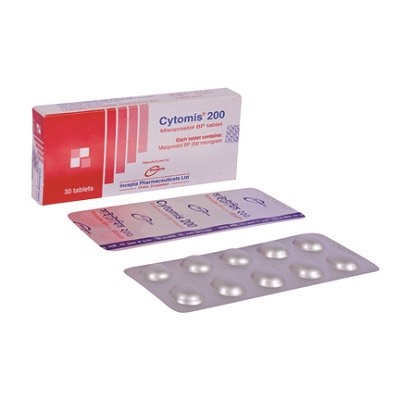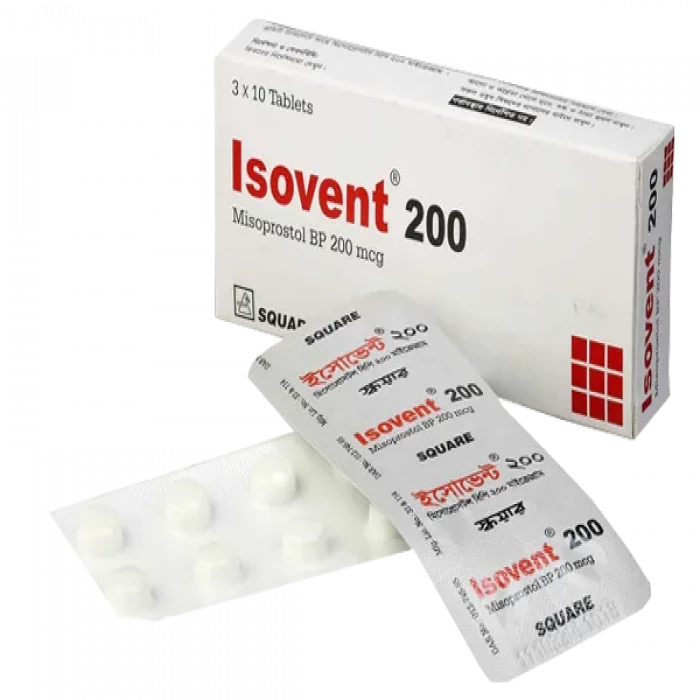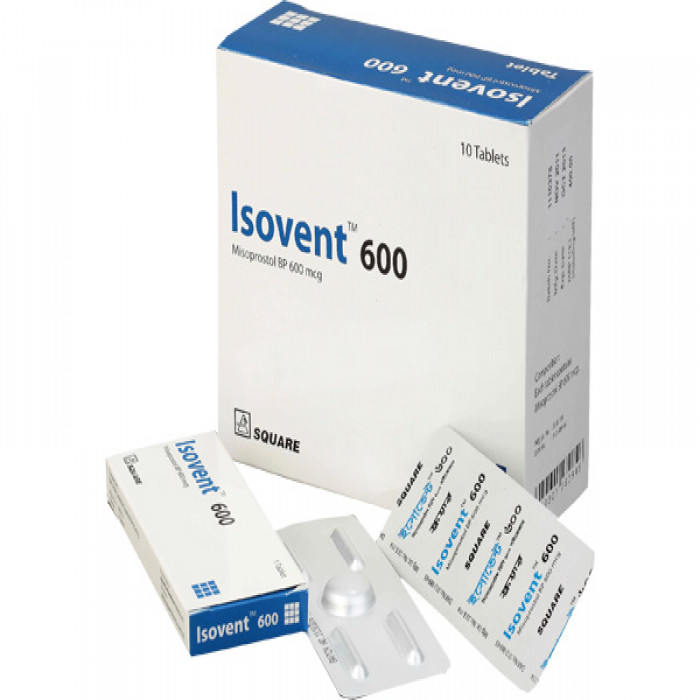
✔ 100% Authentic Product
👁️ Currently Viewing 5306
Cytomis 200mcg Tablet 10pcs
Cytomis 200 is used to induce medical abortions and to manage excessive postpartum bleeding. The medication works by increasing uterine contractions. Cytomis 200 can be used alone or in combination with other drugs. It should be taken with food or according to your doctor's instructions.
Discount
Price: ৳ 141
MRP:
৳
150
6%
Off

100% Genuine Products, Guaranteed

Safe & Secure Payments, Always

Fast, Secure & Efficient Delivery

Proper Packaging
 Cash on Delivery - All over Bangladesh
Cash on Delivery - All over Bangladesh Regular Delivery - 12-24 Hours, Dhaka City* Charge Tk.39-59
Regular Delivery - 12-24 Hours, Dhaka City* Charge Tk.39-59 Regular Delivery - 24-48 Hours, Other Cities* Charge Tk.99-110
Regular Delivery - 24-48 Hours, Other Cities* Charge Tk.99-110
 ফ্রি ডেলিভারিঃ - ৯৯৯ টাকা+ অর্ডারে, ঢাকা
শহরে
ফ্রি ডেলিভারিঃ - ৯৯৯ টাকা+ অর্ডারে, ঢাকা
শহরে ফ্রি ডেলিভারিঃ - ২৯৯৯ টাকা+ অর্ডারে, ঢাকার
বাহিরে
ফ্রি ডেলিভারিঃ - ২৯৯৯ টাকা+ অর্ডারে, ঢাকার
বাহিরে
100% Genuine Products, Guaranteed
Safe & Secure Payments, Always
Fast, Secure & Efficient Delivery
Proper Packaging
 Cash on Delivery - All over Bangladesh
Cash on Delivery - All over Bangladesh Regular Delivery - 12-24 Hours, Dhaka City* Charge Tk.39-59
Regular Delivery - 12-24 Hours, Dhaka City* Charge Tk.39-59 Regular Delivery - 24-48 Hours, Other Cities* Charge Tk.99-110
Regular Delivery - 24-48 Hours, Other Cities* Charge Tk.99-110 ফ্রি ডেলিভারিঃ - ৯৯৯ টাকা+ অর্ডারে, ঢাকা
শহরে
ফ্রি ডেলিভারিঃ - ৯৯৯ টাকা+ অর্ডারে, ঢাকা
শহরে ফ্রি ডেলিভারিঃ - ২৯৯৯ টাকা+ অর্ডারে, ঢাকার
বাহিরে
ফ্রি ডেলিভারিঃ - ২৯৯৯ টাকা+ অর্ডারে, ঢাকার
বাহিরে
✅ Description:
Cytomis 200mcg Tablet contains Misoprostol, a medication that falls under Prostaglandin Analogs. It's primarily used to manage peptic ulcers, especially those caused by excessive use of NSAIDs like diclofenac or naproxen.
This medication can also aid in cervical ripening before certain uterine procedures, induce labor, and is used in combination with mifepristone (an abortion pill) for early pregnancy termination (first trimester). Additionally, it can help manage excessive bleeding after childbirth.
To minimize stomach upset, take Cytomis 200mcg Tablet with meals. Avoid using antacids that contain magnesium, as they can increase the risk of severe stomach issues.
Before starting this medication, inform your doctor if you have a history of cesarean section, heart issues, high or low blood pressure, inflammatory bowel diseases, or blood vessel problems.
Pregnant women should not use Cytomis 200mcg Tablet due to risks of abortion or serious birth defects. It is also not recommended for breastfeeding women or children under 18 years. Women who could become pregnant must use effective contraception while taking this medication.
✔️ Uses of Cytomis 200mcg Tablet
- Manage and manage peptic ulcer, predominantly caused due to excessive NSAID use (such as diclofenac, and naproxen)
- Used for cervical ripening (before certain uterine procedures)
- Used for inducing labor pain
- Can induce abortion during the first trimester of pregnancy
- Prevents excessive blood loss after childbirth
✔️ Side Effects of Cytomis 200mcg Tablet
Misoprostol is generally well-tolerated. Common side effects include gastrointestinal symptoms such as diarrhea, abdominal pain, dyspepsia, flatulence, nausea, vomiting, rashes and dizziness. To reduce diarrhea, take the medication with meals and at bedtime, and avoid antacids containing magnesium.
✔️ How does Cytomis 200mcg Tablet work?
Cytomis 200 reduces excessive stomach acid caused by prolonged NSAID use, aiding in ulcer healing, preventing new ulcers, and alleviating GI symptoms like acidity and heartburn.
It also stimulates uterine contractions to initiate labor, reduce postpartum bleeding, and induce early pregnancy abortion. Additionally, it helps soften the cervix for uterine procedures.
✔️ Before taking Cytomis 200 inform your doctor if you:
- previously delivered a baby via cesarean section
- have any problems in blood vessels
- have inflammation in the bowel (such as ulcerative colitis, Crohn’s disease)
- are more prone to dehydration easily
✔️ Indications
Misoprostol is used for medical abortion and to treat post-delivery bleeding.
✔️ Pharmacology
Misoprostol, the active ingredient, is quickly converted to its free acid form, which is responsible for its therapeutic effects and is detectable in plasma. This free acid is extensively absorbed. Taking Misoprostol with food results in lower peak plasma concentrations, and simultaneous use with magnesium-containing antacids can reduce its overall availability. Misoprostol has mucosal protective properties and antisecretory effects that reduce gastric acid secretion. It counteracts the mucosal damage caused by NSAIDs by enhancing bicarbonate and mucus production in the stomach, although this is significant only at doses of 200 mcg or more.
✔️ Dosage of Cytomis 200mcg Tablet
Gastric and Duodenal Ulcers: For treating benign gastric and duodenal ulcers, including those caused by NSAIDs, the dosage is 800 mcg per day in divided doses (2-4 times) with meals and at bedtime. Treatment should last at least 4 weeks but can be extended up to 8 weeks if necessary.
NSAID-Induced Ulcer Prevention: Take 200 mcg with NSAIDs 2-4 times daily. If the dose is not tolerated, a lower dose of 100 mcg may be used. Follow the prescribed course throughout the NSAID therapy.
Labor Induction: Administer 25 mcg vaginally in the posterior fornix to start labor, repeating as necessary up to a total of 200 mcg every six hours. Alternatively, take 100 mcg orally. If cervical ripening or active labor is not achieved, a repeated oral dose of 100-200 mcg can be given every four hours until labor is established (Bishop score ≥7), with a maximum of six doses. Begin oxytocin four hours after the last Misoprostol dose if needed. Monitor maternal vital signs, fetal heart rate, and contractions. Report any fetal distress or excessive uterine contractions to a doctor.
Postpartum Bleeding: Immediately after delivery, take 600 mcg orally to prevent postpartum bleeding. For postpartum hemorrhage, administer 600 mcg orally or 1000 mcg rectally.
✔️ Administration
Take Cytomis 200mcg Tablet with meals to avoid stomach upset. Swallow the medicine with a glass of water. Do not crush or chew the medicine.
Your doctor will decide the correct dose and duration of therapy for you depending upon your age, body weight, and disease condition.
✔️ Interaction
Misoprostol does not show significant interactions with cardiac, pulmonary, CNS drugs, or NSAIDs. Its bioavailability decreases with high doses of antacids.
✔️ Contraindication
Misoprostol is contraindicated in individuals with a history of prostaglandin allergy and during pregnancy.
✔️ Pregnancy & Lactation
Misoprostol is contraindicated in pregnancy due to its abortifacient properties. It should not be used in women who are or may become pregnant, unless it is essential for NSAID therapy to prevent or treat NSAID-induced ulcers. If prescribed, ensure:
- A negative pregnancy test within two weeks before starting treatment.
- Adherence to effective contraceptive measures.
- Awareness of the risks associated with Misoprostol and the potential for contraception failure.
Although not extensively studied, Misoprostol's active metabolite might be excreted in breast milk. It is not recommended for use by breastfeeding mothers due to potential risks to nursing infants.
✔️ Precautions & Warnings
Misoprostol is contraindicated in pregnant women and should only be used in women of childbearing potential if necessary for NSAID-induced ulcer management. It is essential to confirm the absence of pregnancy before starting treatment and to use effective contraception.
Labor induction using Misoprostol should only be considered if the pregnancy is appropriately dated (36-38 weeks' gestation) and if no contraindications such as acute fetal distress, placental abruption, placenta previa, or unexplained vaginal bleeding are present. The fetus should be in a vertex presentation.
✔️ Storage
Store Cytomis 200 in a cool, dry place, protected from light and moisture. Keep out of reach of children.
⚠️Disclaimer:
At ePharma, we’re committed to providing accurate and accessible health information. However, all content is intended for informational purposes only and should not replace medical advice from a qualified physician. Please consult your healthcare provider for personalized guidance. We aim to support, not substitute, the doctor-patient relationship.








